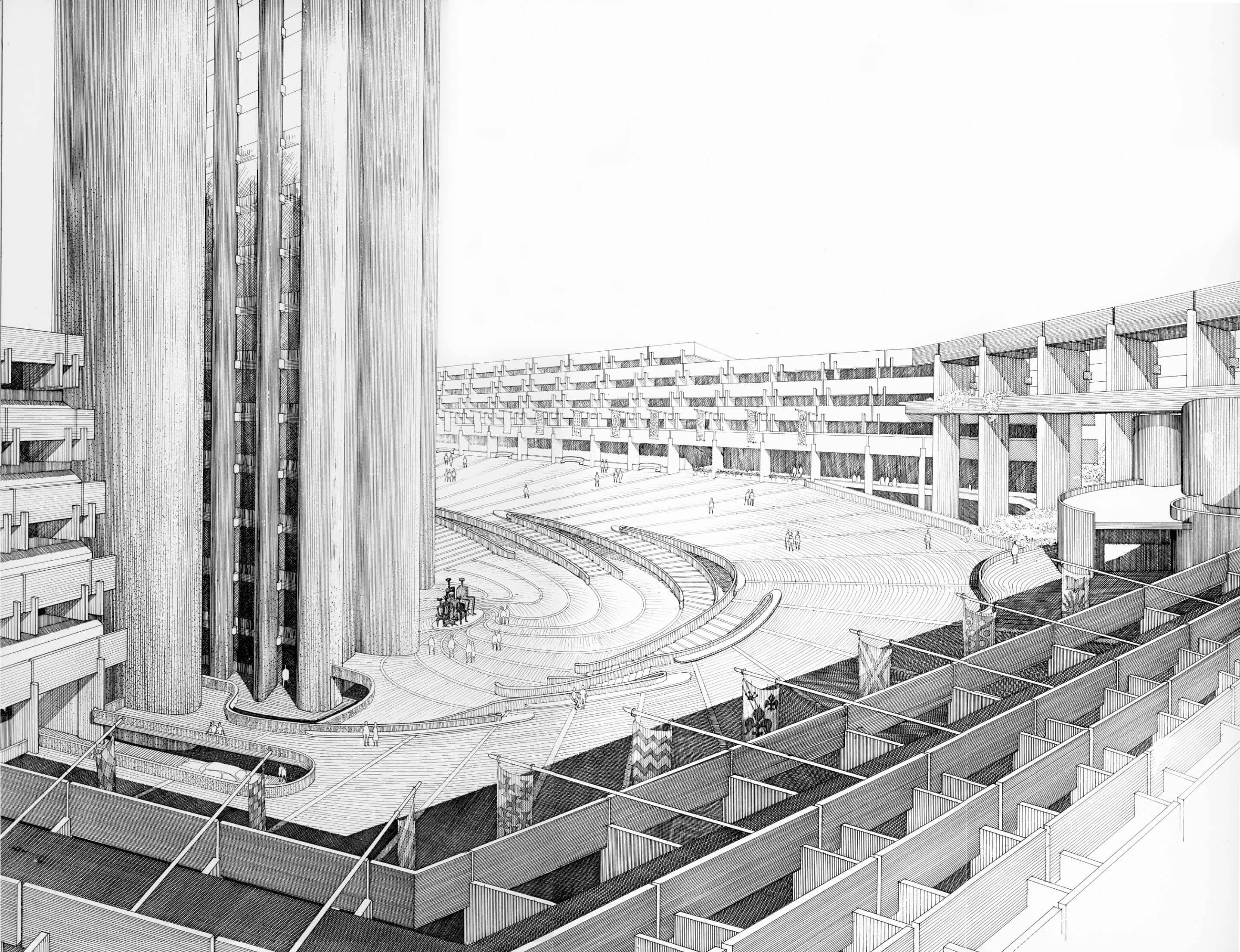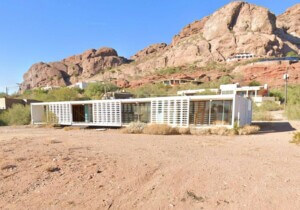The completed works of Paul Rudolph have become a regular target for the concrete-hating development crowd. Buildings such as the Burroughs Wellcome headquarters in Durham, North Carolina, and the Shoreline Apartments in Buffalo, New York, were demolished with scarcely any acknowledgment of their architectural significance.
The architect’s civic buildings haven’t fared much better. In 2017, the original composition of the Orange County Government Center in Goshen, New York, was marred beyond repair, and a new, incongruous structure was erected alongside the remnants of Rudolph’s original. Now the Rudolph-designed Government Services Center in Boston, particularly the portion referred to as the Charles F. Hurley Building, is at risk of the same.
The Government Services Center is a multi-block scheme first developed by the Boston Redevelopment Authority under Ed Logue. Opened in 1971, the complex was conceived alongside a wider downtown rejuvenation project that cleared a significant part of the area to make way for a new Government Center, which also included City Hall and the Federal Office Building. (These were designed by Kallmann McKinnell & Knowles and The Architect’s Collaborative, respectively; the overall plan was prepared by I. M. Pei’s office, with oversight from Henry Cobb.) These admittedly extreme interventions had an outsized effect in shaping modern Boston and helped catalyze a renewal of the city that has continued to the present day.
The two pieces of the Center—the Hurley Building and the adjacent Erich Lindemann Mental Health Center—are monumental works featuring rugged, bush-hammered concrete and distinctive curvilinear forms, such as the Hurley’s iconic “frog,” which peers over Merrimac Street, and the staircases that spin out onto a public plaza. But the greater project, which Rudolph coauthored with Desmond & Lord and Shepley Bulfinch Richardson and Abbott, remained incomplete: A soaring tower, designed but never built, would have anchored the site and enclosed a courtyard that Rudolph imagined as a welcoming refuge. As a result, a stagnant air clung to the Government Services Center for decades, which even the addition of Kallmann McKinnell & Wood’s Edward W. Brooke Courthouse in 1999 failed to lift.
The complex also suffered at the combined hands of deferred maintenance and active neglect, making it less and less accessible. Points of entry were closed off and large stretches of both buildings were surrounded by a fence, which certainly didn’t enhance the appeal of the neglected plaza. Worse, public spaces at the foot of the Hurley along Merrimac and alongside the Lindemann Center were converted to parking lots.

Acknowledging these deficits, the state moved to redevelop the Government Services Center site in late 2019, tacitly sacrificing the Hurley Building in the process. The decision, while heralded by some, sparked an outcry from the Boston Preservation Society and the Massachusetts Historical Commission, among others. A report on the complex highlighted the architectural significance of Rudolph’s buildings, as well as the superlative Costantino Nivola murals that hang in the Hurley’s lobby.
These arguments appeared to sway the state’s Division of Capital Asset Management and Maintenance (DCAMM), and in 2020, the agency issued an RFP to transform the area while offering several options for retention, or complete removal, of the Hurley Building. (The Lindemann Center, a project more authoritatively “Rudolphian,” was not included in the scope of renovation/restoration.) In examining these options, proponents of saving Boston’s postwar concrete architecture such as myself saw an opening.
Convinced that there was a way to preserve the Hurley Building, I consulted on a scheme that would bring the complex up to current building performance standards. The existing structure could be repurposed as research laboratories and offices for biotech companies, or start-ups looking for open office solutions, and the expansive floor plates offer a rough-and-ready backdrop for inventive space planning. A rethinking of the landscape would render two acres of open space for public use, opening up now-closed entrances to reintroduce foot traffic across the plaza. The strategic addition of ground-floor retail would bring commerce to a place left barren for far too long. Lastly, a tower equal to the one proposed by Rudolph and his team would “complete” the architectural ensemble, its base a hybrid public space that would enhance the urban legibility of the site.
We were on the verge of submitting the project when we were informed that the tower wouldn’t conform to the line the state had drawn between the courthouse and new development, which ruled out using the open part of the site for the tower structure, even if it was a public space. Four other proposals were submitted, but their schemes and strategies for preserving the Hurley remain unknown. A scheme will supposedly be chosen this month, but there has been no public airing of the results.
Our project was informed by earlier efforts to help redefine attitudes toward City Hall, closely identified with the architectural “third rail” of Brutalism. These proactive efforts turned the tide of public opinion on the building, whose 50th anniversary was celebrated by then-mayor Marty Walsh and its architect, Michael McKinnell. Boston now has, in Michelle Wu, a mayor who unabashedly admires the building, and a multiphase renovation will make City Hall and its capacious plaza more accessible than ever, demonstrating how even the most despised buildings can be rediscovered through investment and care.
Unfortunately, a similar rehabilitation may not be in the works for the Hurley. Despite its earlier assurances, and against the grain of preservationists, DCAMM appears to have chosen a path toward replacement of the Hurley structures. If so, it’s an unnecessary, costly decision that ignores the robust armature that the building offers as an artifact for reuse and reinvention.
It’s no secret that the courthouse would like to absorb the land on which the Hurley stands. At the same time, the state stands to gain a large sum from selling off the property; undoubtedly, developers would be champing at the bit. Meanwhile, local community groups have argued that the site, unburdened of its concrete behemoth, could be returned to public use. There doesn’t seem to be any appetite for the kind of radical vision that the architects of the Government Services Center were willing to embrace—and that Rudolph himself continued to pursue throughout his later career, as seen in the experimental residential and commercial spaces he built in Southeast Asia.
Architectural ambition and development shouldn’t be seen as mutually exclusive concerns. Here, preservationist arguments that place value on an eclectic city take on greater force. Such an outlook celebrates all elements of urban history, including those we don’t particularly find beautiful, for as history suggests, standards of beauty are not fixed in place but oscillate over time—Victorian architecture was despised, then loved, just as so-called “concrete monsters” are now admirable Brutalist avatars. That the now over half-century-old Government Services Center has become part of the historical context upon which the modern preservation movement was founded, why not use the same tactics to ensure it receives the care and attention it deserves?
Chris Grimley is a designer and curator based in Boston. He is the author of Heroic: Concrete Architecture and the New Boston (The Monacelli Press, 2015); Imagining the Modern: Architecture and Urbanism of the Pittsburgh Renaissance (The Monacelli Press, 2019); and designer of Henry N. Cobb: Words & Works 1948–2018: Scenes from a Life in Architecture (The Monacelli Press, 2018).











